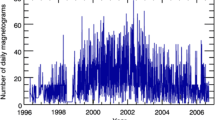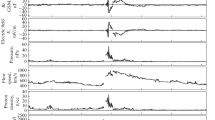Abstract
Aiming at two intense shock events on October 28 and 29, 2003, this paper presents a two-step method, which combines synoptic analysis of space weather — “observing” and quantitative prediction — “palpating”, and then uses it to test predictions. In the first step of “observing”, on the basis of observations of the solar source surface magnetic field, interplanetary scintillation (IPS) and ACE spacecraft, we find that the propagation of the shocks is asymmetric relative to the normal direction of their solar sources, and the Earth is located near the direction of the fastest speed and the greatest energy of the shocks. As the two fast ejection shock events, the fast explosion of coronal mass of the extremely high temperature, the strong magnetic field, and the high speed background solar wind are also helpful to their rapid propagation. In the second step of “palpating”, we adopt a new membership function of the fast shock events for the ISF method. The predicted results show that for the onset time of the geomagnetic disturbance, the relative errors between the observational and the predicted results are 1.8% and 6.7%; and for the magnetic disturbance magnitude, the relative errors are 4.1% and 3.1%, respectively. Furthermore, the comparison among the predicted results of our two-step method with those of five other prevailing methods shows that the two-step method is advantageous. The results tell us that understanding the physical features of shock propagation thoroughly is of great importance in improving the prediction precision.
Similar content being viewed by others
References
Wei F S, Zhu Z W. Space Weather. Science (in Chinese), 1999, 5: 30–33
Wei F S. Elementary problems in space weather. Chin Basic Sci (in Chinese), 2000, 7: 9–13
Gopalswamy N, Barbieri L, Lu G, et al. Introduction to the special section: Violent Sun-Earth connection events of October–November 2003. Geophys Res Lett, 2005, 32(3): L03S01
Lopez R E, Baker D N, Allen J E. Sun unleashes Halloween storm. Eos Trans AGU, 2004, 85: 105–108
Webb D, Allen J. Spacecraft and ground anomalies related to the October–November 2003 solar activity. Space Weather, 2004, 2(3): S03008
Suo Y C, Zhang T Y. One big solar-terrestrial event in 2003. Milit Meteor (in Chinese), 2004, 3: 34–36
Barbieri L P, Mahmot R E. October–November 2003s’s space weather and operations lessons learned. Space Weather, 2004, 2(9): S09002
Skoug R M, Gosling J T, Steinberg J T, et al. Extremely high speed solar wind: 29–30 October 2003. J Geophys Res, 2004, 109(A9): A09102
Zurbuchen T H, Gloeckler G, Ipavich F, et al. On the fast coronal mass ejections in October/November 2003: ACE-SWICS results. Geophys Res Lett, 2004, 31(11): L11805
Malandrakil O E, Lario D, Lanzerotti L J, et al. October/November 2003 ICMEs: ACE/EPAM solar energetic particle observations. J Geophys Res, 2005, 110(A9): A09S19
Lario D, Livil S, Krimigisl S M, et al. Heliospheric energetic particle observations during the October–November 2003 events. J Geophys Res, 2005, 110(A9): A09S11
Kuwabara T, Munakata K, Yasue S, et al. Geometry of an interplanetary CME on October 29, 2003 deduced from cosmic rays. Geophys Res Lett, 2004, 31(19): L19803
Woods T N, Eparvier F G, Fontenla J, et al. Solar irradiance variability during the October 2003 solar storm period. Geophys Res Lett, 2004, 31(10): L10802
Cary O. Prediction performance of space weather forecast centers following the extreme events of October and November 2003. Space Weather, 2004, 2(8): S08001
Dryer M, Smith Z, Fry C D, et al. Real-time shock arrival predictions during the “Halloween 2003 Epoch”. Space Weather, 2004, 2(9): S09001
Wei F S, Dryer M. Propagation of solar flare-associated interplanetary shock waves in the heliospheric meridional plane. Solar Phys, 1991, 132: 373–394
Wei F S. The blast wave propagating in a moving medium with variable density. Chin J Space Sci (in Chinese), 1982, 2(1): 63–72
Wei F S. Preliminary results of predicting geomagnetic SSC by using IPS observations. Acta Geophys Sin (in Chinese), 1984, 27(5): 417–423
Wei F S, Cai H C. Primary application of the membership functions in the geomagnetic disturbance predictions. Chin J Space Sci (in Chinese), 1990, 10(1): 35–41
Wei F S, Xu Y, Feng X S, et al. Prediction tests by using “ISF” method for the geomagnetic disturbances. Sci China Ser E-Technol Sci, 2002, 45(5): 525–530
Wei F S, Cai H C, Feng X S, et al, A prediction method of geomagnetic disturbances based on IPS observations-dynamics-fuzzy mathematics. Adv Space Res, 2003, 31(4): 1069–1073
Manoharan P K, Gopalswamy N, Yashiro S, et al. Influence of coronal mass ejection interaction on propagation of interplanetary shocks. J Geophys Res, 2004, 109(A6): A06109
Cho K S, Moon Y J, Dryer M, et al. A statistical comparison of interplanetary shock and CME propagation models. J Geophys Res, 2003, 108(A12): 1445–1452
Author information
Authors and Affiliations
Corresponding author
Rights and permissions
About this article
Cite this article
Xie, Y., Wei, F., Feng, X. et al. Prediction method for October 2003 solar storm. SCI CHINA SER E 49, 629–640 (2006). https://doi.org/10.1007/s11431-006-2021-2
Received:
Accepted:
Issue Date:
DOI: https://doi.org/10.1007/s11431-006-2021-2




